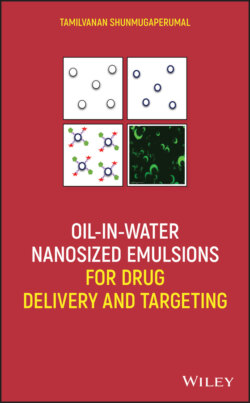Читать книгу Oil-in-Water Nanosized Emulsions for Drug Delivery and Targeting - Tamilvanan Shunmugaperumal - Страница 29
2.2.2. Issues Related to Emulsifier Selection to Stabilize the O/W Nanosized Emulsions for Medical Application
ОглавлениеNot only the chemical nature of emulsifiers but also their concentration used determine the type of emulsion produced. For example, the spontaneously forming thermodynamically stable microemulsion systems require a high emulsifier/surfactant concentration [usually at 20% and higher (w/w)] along with an alkanol component. But the kinetically stable nanosized emulsions can be prepared by using relatively lower surfactant concentrations. For example, a 20% o/w nanosized emulsion may only require a surfactant concentration of 1–5%. The kinetic stability of the nanosized emulsions can be achieved by creating a barrier at the oil–water interface, protecting the emulsion from breakage (Capek 2004). These barriers may be of electrostatic or steric nature and prevent emulsion droplets from direct contact. The most common way to stabilize emulsions is by surfactant adsorbed at the interface between the dispersed oil droplets and continuous aqueous dispersion medium. Surfactant adsorption layers do not only reduce the interfacial tension but can also provide an electrical charge to the emulsion droplets (ionic surfactants) or create the strong steric barrier via bulky molecular groups directed toward the dispersion medium (nonionic surfactants).
Traditionally, lecithins or phospholipids are the emulsifiers of choice to produce o/w nanosized emulsions, because the phospholipid emulsifier molecule structure is more or less similar to the endogenous phospholipids, which build the cells and/tissues. However, additional emulsifiers preferably dissolved in the aqueous phase are usually included in the emulsion composition. A typical example of the aqueous soluble emulsifiers are nonionic surfactants (e.g., Tween 20), which are preferred because they are less irritant than their ionic counterparts. The nonionic block copolymer of polyoxyethylene‐polyoxypropylene (PEO‐PPO), Pluronics F68 (Poloxamer 188) is included to stabilize the emulsion through strong steric repulsion. However, surfactants such as Miranol MHT (lauroamphodiacetate and sodium tridecethsulfate) and Miranol C2M (cocoamphodiacetate) were also used in earlier ophthalmic emulsions (Muchtar and Benita 1994). It should be added that commercially available cyclosporin A‐loaded anionic emulsion (Restasis®) contains only polysorbate 80 and carbomer 1,342 at alkaline pH to stabilize the anionic emulsion. To prepare a cationic emulsion, cationic lipids (stearyl‐and oleyl‐amines) or polysaccharides (chitosan) are added to the formulation. Strikingly, a stable emulsion prepared based on chitosan–lecithin combination was also reported (Ogawa et al. 2003). Conversely, a cationic emulsion based on an association of poloxamer 188 and chitosan without the incorporation of lecithin was prepared and also demonstrated adequate stability (Calvo et al. 1997; Jumaa and Müller 1999). Similarly, a report from our group also indicated the stability of oil droplets through the cation conferring chitosan along with poloxamer 188 as a mixed emulsifier (Tamilvanan et al. 2010). Since the free fatty acid generating phospholipid emulsifier molecule is omitted from the nanosized emulsion system, the stable nanosized emulsion produced from chitosan–poloxamer emulsifier combination would significantly reduce the generation of microclimate acidic pH in the vicinity of oil phase, oil–water interface, and water phase of the emulsion (Tamilvanan et al. 2010). These non‐phospholipid‐based emulsions should therefore pave the way to incorporate the acid‐labile molecules like therapeutic peptides and proteins, and to delineate the scope of applying lyophilization process for the development of a solid or dry emulsion. With the addition of suitable cryo‐ or lyo‐protectant at optimum concentration, the preparation of lyophilized solid dry‐powder form of non‐phospholipid‐based o/w nanosized emulsions is possible in recent years. Figure 2.1 shows the o/w nanosized emulsions in liquid form (before lyophilization) and solid‐dry powder form after the addition of different cryo‐ or lyo‐protectant molecules.
Oil‐in‐water emulsion compositions based on α‐tocopherol (or α‐tocopherol derivative) as the disperse phase has been described in a patent granted to Dumex (Sonne 2015). Interestingly, the emulsifying agent used to make tocol‐based emulsions are restricted to vitamin E TPGS (D‐alpha‐tocopheryl polyethylene glycol 1000 succinate) taking into consideration of toxicological issues. According to a patent by Nakajima et al. (2003), functional emulsions for use in food, APIs, and cosmetics were reported. These emulsions were stabilized with various span products such as Span 80, Span 40, etc. There is a group of emulsions that were not prepared by using the traditional anionic, cationic, and nonionic surfactant molecules. These emulsions do contain the oil or oil combination and therefore they can be termed as “surfactant‐free emulsions.” Another group of colloidal dispersions whose final appearance is white similar to the traditional emulsions but these dispersions do not contain both surfactants and oil or oil combination. Taking the physical appearance (white color) into consideration, these colloidal dispersions get the term “surfactant‐ and oil‐free emulsions.” Both of these two emulsions (surfactant‐free and surfactant‐ and oil‐free) are briefly discussed in Chapter 7.
Figure 2.1. Freeze‐dried emulsions using different cryo‐ or lyo‐protectants and reconstitution of freeze‐dried powder into nanosized emulsion.
